According to the “experts” Belted Kingfishers usually don’t submerge when they dive for fish. This bird didn’t read that book.
Four days ago I spent about an hour with a female Belted Kingfisher as she worked at filling her belly with fish near the Jordan River. Her fishing skills were impressive but her dives were so very fast that it bordered on impossible for me to document the process. That doesn’t mean I didn’t try.
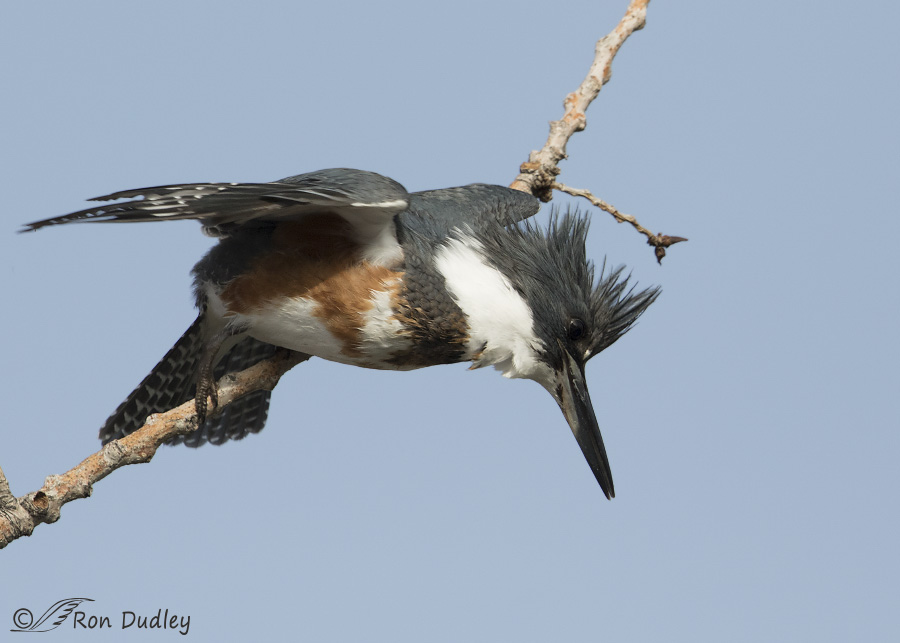
1/2500, f/7.1, ISO 500, Canon 7D Mark II, Canon EF 500mm f/4L IS II USM + 1.4 tc, not baited, set up or called in
Most often she watched for fish near the water’s surface from branches overlooking the water. I tried to catch her in a dramatic take-off posture as she dived but she was so danged fast that this is as close as I came without clipping body parts.
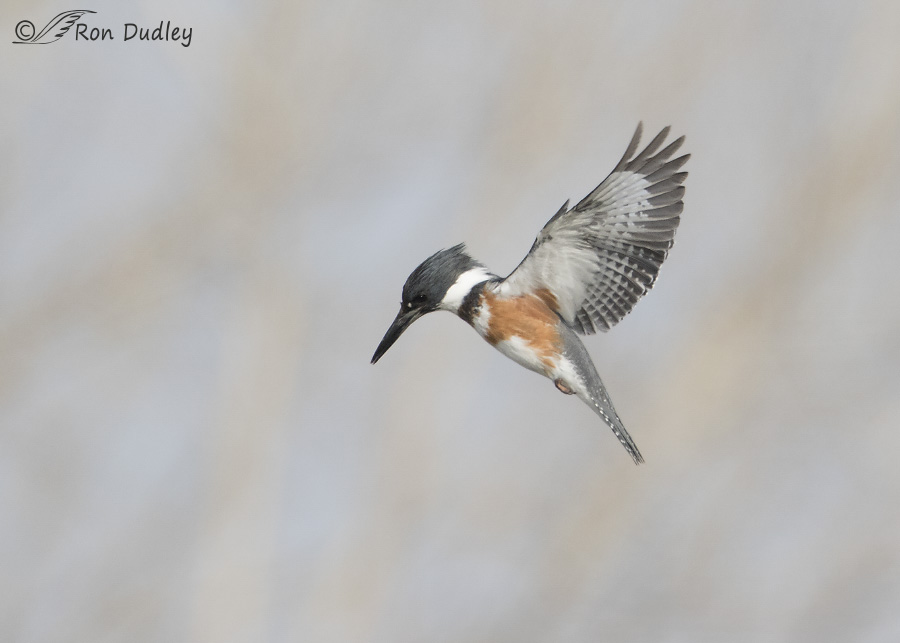
1/4000, f/6.3, ISO 800, Canon 7D Mark II, Canon EF 500mm f/4L IS II USM + 1.4 tc, not baited, set up or called in
But occasionally she fished by hovering over the surface of the water.
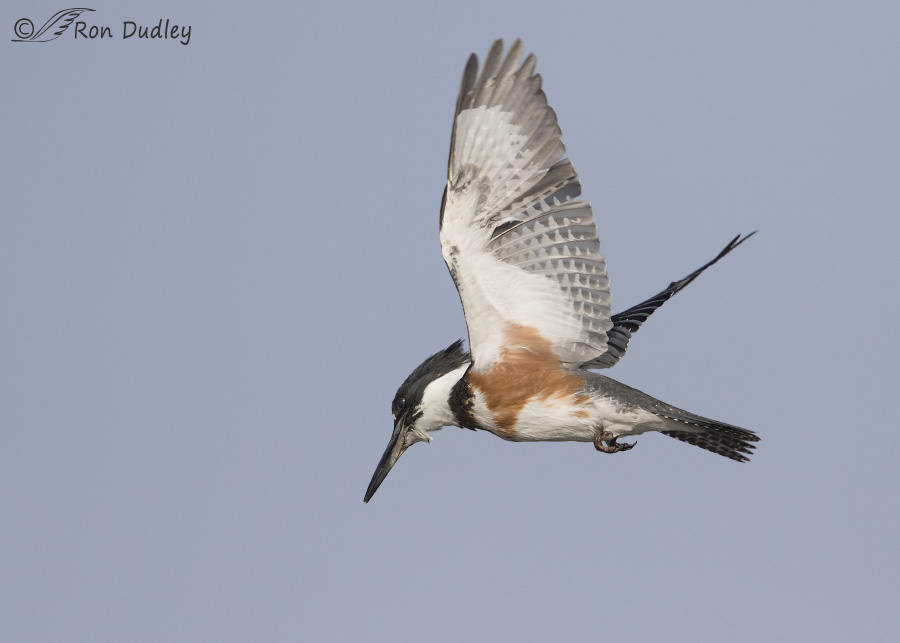
1/4000, f/6.3, ISO 640, Canon 7D Mark II, Canon EF 500mm f/4L IS II USM + 1.4 tc, not baited, set up or called in
Here she’s hovering as she scans the water below her and an instant later…
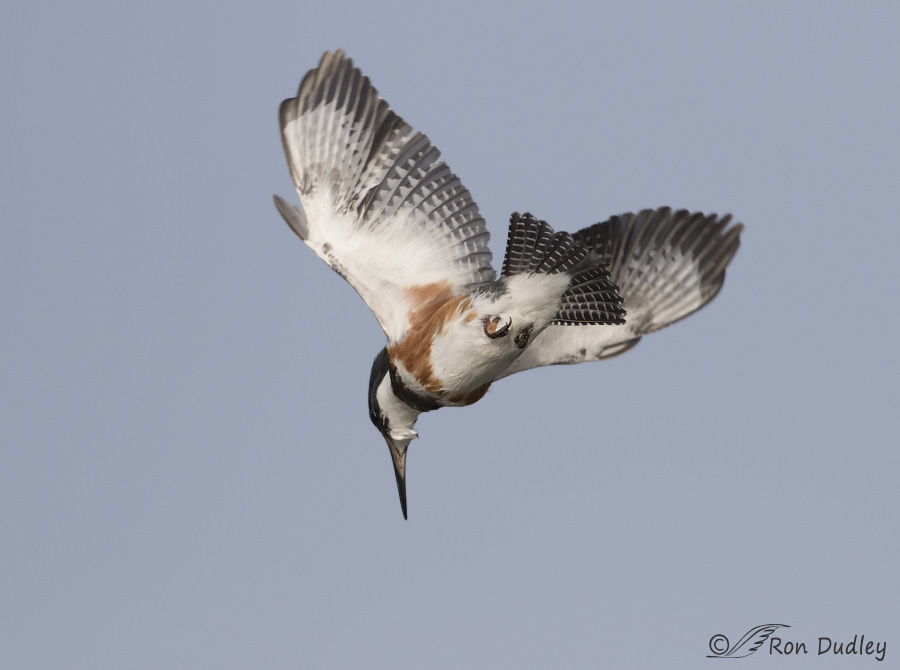
1/4000, f/6.3, ISO 640, Canon 7D Mark II, Canon EF 500mm f/4L IS II USM + 1.4 tc, not baited, set up or called in
she spotted a fish and began her dive.
Birds of North America Online out of Cornell has this to say about diving Belted Kingfishers – “Because prey are usually near the water surface, the bird typically does not submerge”. We’ll see if this bird followed that script.
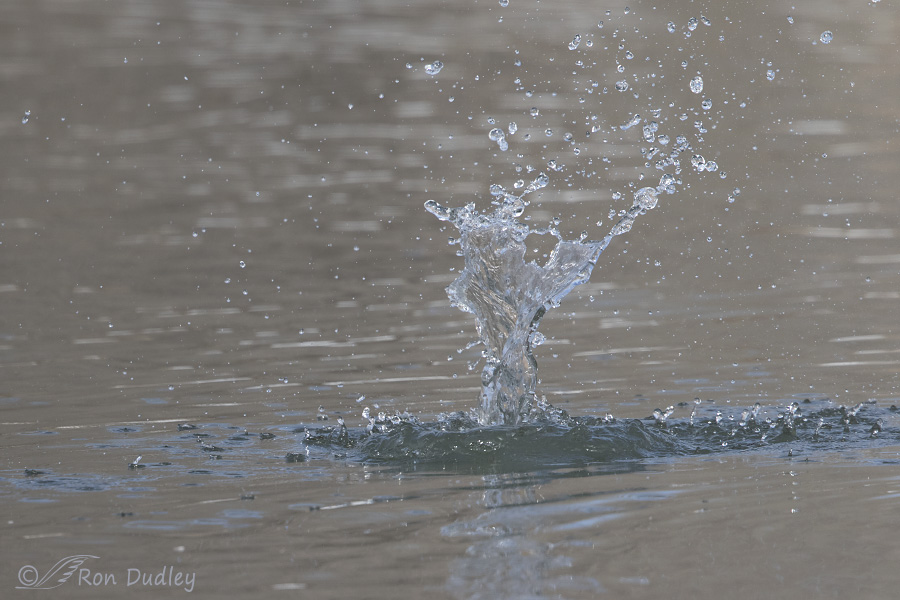
Here the kingfisher has just entered the water (one day I’d like to photograph the actual entry but that has to be one of the biggest challenges in bird photography). The bird appears to be completely submerged but the following sequential images should tell the tale.
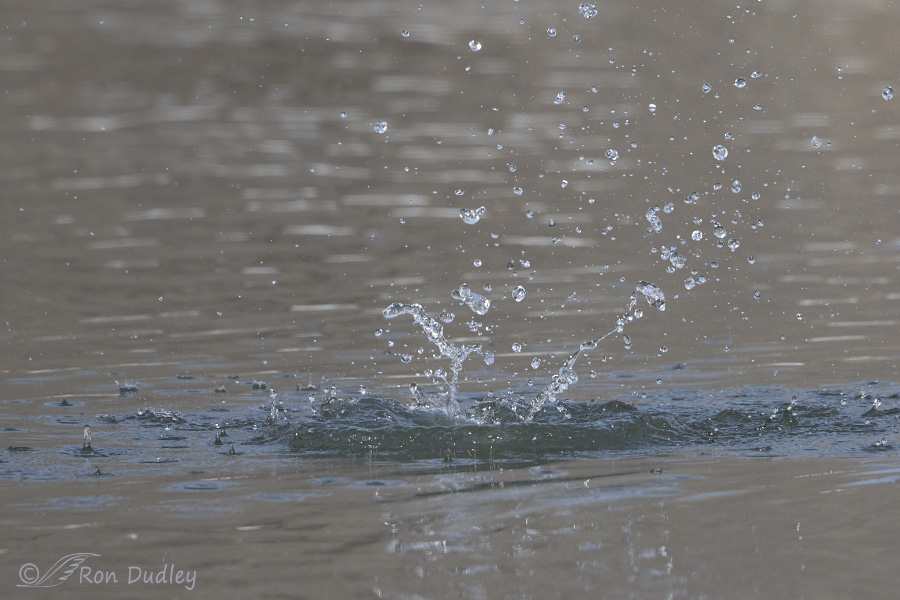
This looks like total submersion to me.
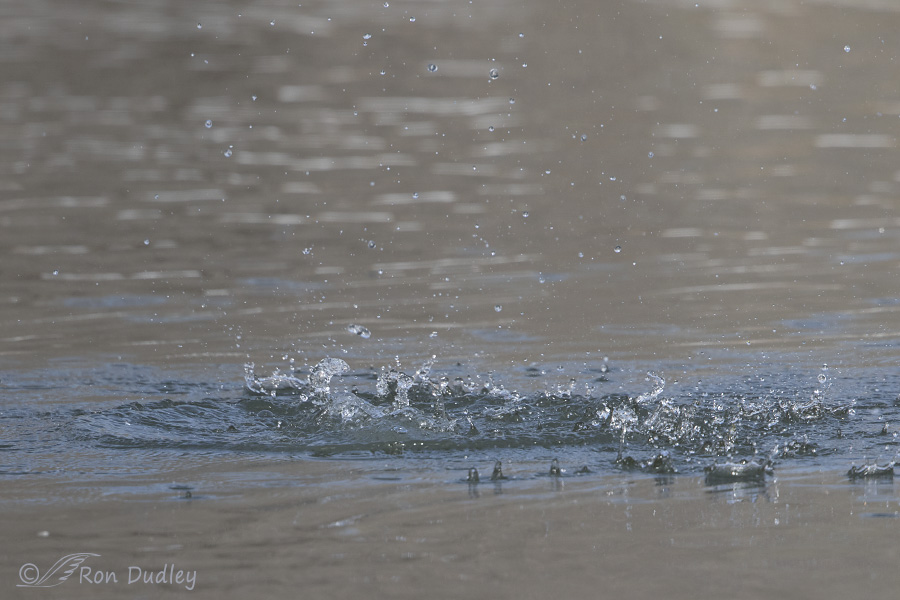
Still no sign of her.
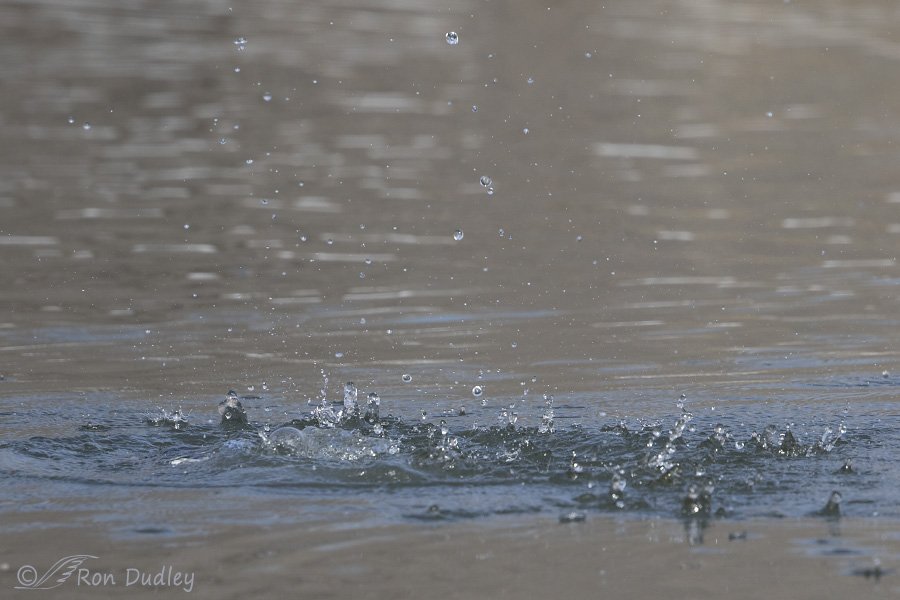
Where is she?
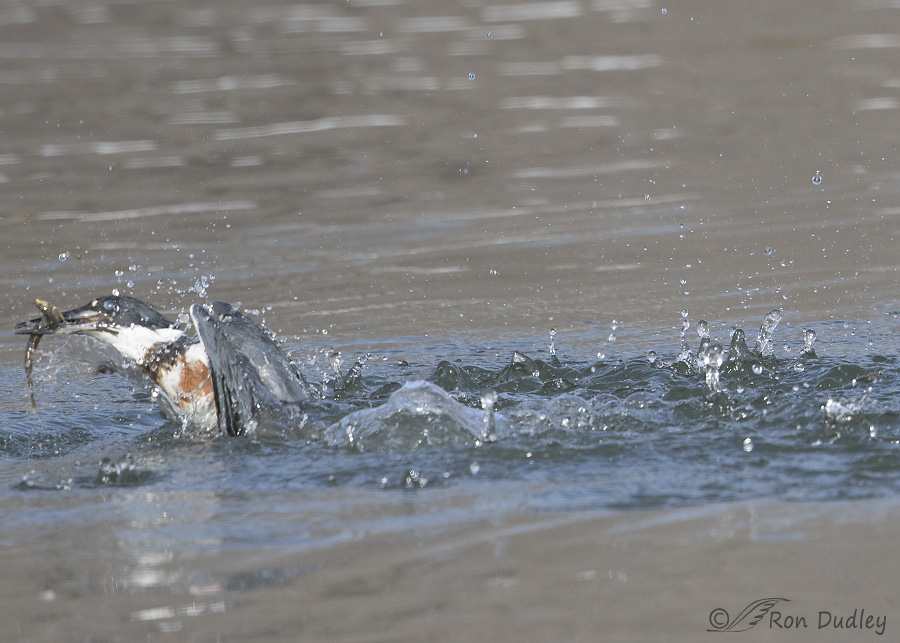
Finally she emerges with a fish (in this case another Weather Loach).
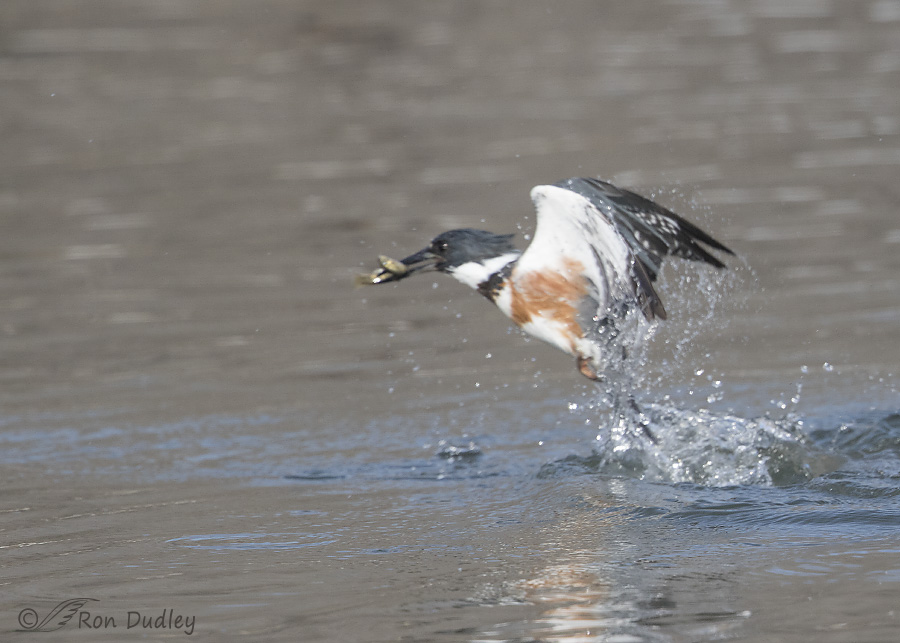
This shot is very soft but I decided to include it for the sake of continuity.
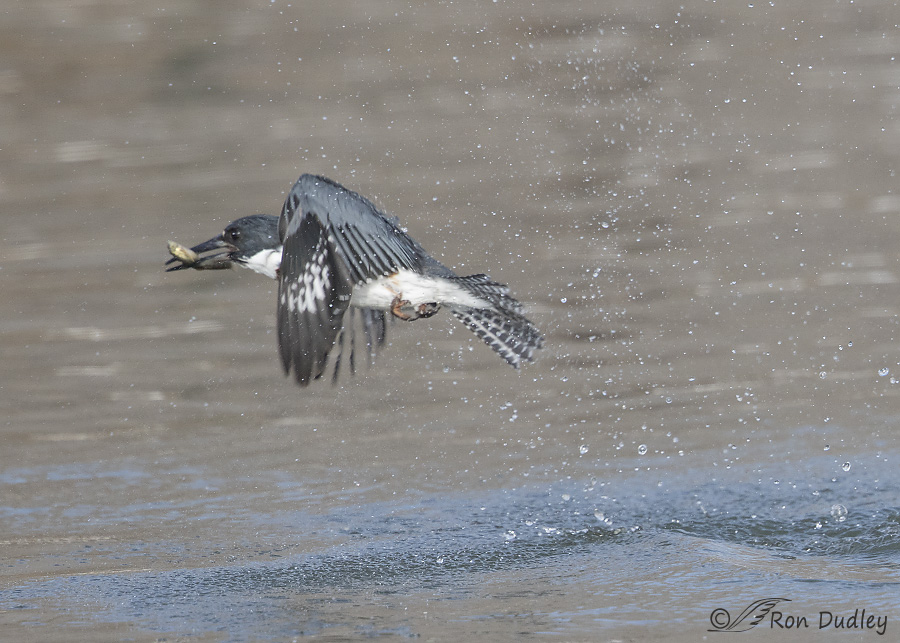
In the last image of the series the kingfisher makes her escape with the fish.
I certainly don’t question the accuracy of BNA’s statement that kingfishers “typically do not submerge” – after all, “typically” doesn’t mean “always”. But I was happy to photograph this apparent exception.
Interestingly, BNA also says that kingfishers actually enter the water “with eyes closed”. If they catch a fish that’s a pretty neat trick!
Ron


Mouth agape. In total awe and joy for you (and us), Ron!
NEVER have seen this sequence photographed so well. Thanks for sharing!
Hi Ron,
Although usually silent, I follow your blog closely with daily notifications, and always appreciate your information and admire your photography, often to the point of jaw dropping amazement.
I am breaking my silence only to offer a comment on the BNA article on Belted Kingfisher habits. If you are referring to BNA Online, I agree they are unusually confusing regarding the habits of this bird. In the Introduction they describe it as “plunge-diving,” which certainly suggests total submersion. Then in the Food Habits section they say it typically does not completely immerse. Later still, in the Behavior section they offer some clarification, and I quote: “In deep water, a bird sometimes disappears momentarily below the surface, immersing the entire body; rarely submerges in shallow water”. I hope this of some interest/help.
Finally, now that I have your attention: Can I have permission to post a link to your blog on the facebook page of a local birding group I belong to here in southern Manitoba? (The facebook group is “Interlake Birds,” in case you first want to check us out.
Many thanks.
Bill, Yes, I was referring to BNA Online (as I mentioned in my text). Thank you for pointing out what BNA said in the behavior section – I missed that. What I presented here was from the Food Habits section. Agree that it’s confusing to have them at least imply something slightly different in different sections but when I read all three sections more carefully I don’t think they contradicted themselves. From writing my own blog I can appreciate how difficult it must be for BNA to get everything right (and clear) in such a massive project as BNA.
And yes, you may post a link to my blog on FB or any other social media whenever you like (as may anyone else, anytime, without asking). In fact I encourage it. What I have a (very serious) problem with is folks lifting my images from my blog and then posting them to social media or anywhere else. Thank you for asking but it isn’t necessary to do so.
Okay, couldn’t get on the computer until late, but by golly, you nailed it, Ron!! Pics of kingfishers I have always wanted to see! Just fantastic! I love your expertise and your dedication, and your willingness to share with us! And PLEASE, don’t ever exclude soft photos when they are as exciting and informative as these!! As far as what the “professionals” say, I just think it is exciting to see what is actually happening. Maybe the experts have never seen it before. Hope you send them this series. I think they would welcome it! It is so exciting to see that first image of her determined hunting, then the spotting, dive, then the images of the entrance into the water – hello, experts, into the depths. And then the shot of her emerging. WOW! Who else has ever photographed that series!!! What an experience! Thank you so much!
And then the shot of her emerging. WOW! Who else has ever photographed that series!!! What an experience! Thank you so much!
Wow…just an amazing series of photos Ron! Nemesis no more!!!!!
Great series!
Thanks, Arwen.
Experts, Shmexperts…
Like the weather boffins I frequently think that if they opened their eyes they would change their story.
And you are right. IF the Belted Kingfisher has its eyes closed under water to actually catch a fish is a testament to their speed and precision.
Another brilliant series. As always, megathanks.
Ha, I see that the weather folks cause you consternation too, EC.
They drive me absolutely BONKERS. Knowing weather, clouds and light beforehand is so very important to me as a bird photographer but usually a pair of dice would give me more accurate prognostications.
I wish they’d follow Laura’s advice to “know what you don’t know” and just admit it out front!
Ellie Baby–You, and Burrowing owls, always make me laugh!
That is high praise. I am not nearly as cute as Burrowing Owls, but channel their goofiness well.
Insert standing WOW with a YOWZER for emphasis! Just a SPECTACULAR series of images of a magically cool kingfisher! If you don’t know that you don’t know what you don’t know, you can’t be an expert on anything. Birds, critters and even humans do what they need to do to get through the day, even if it’s something they (supposedly) can’t do or have never done previously. And they don’t read any of the books or look at any of the maps. Just my opinion and I’m NOT an expert on anything!
If you don’t know that you don’t know what you don’t know, you can’t be an expert on anything. Birds, critters and even humans do what they need to do to get through the day, even if it’s something they (supposedly) can’t do or have never done previously. And they don’t read any of the books or look at any of the maps. Just my opinion and I’m NOT an expert on anything!
As for the expert thing, if said expert comes anywhere near the concepts of always and never when describing bird/critter behavior, you can be 100% certain that they’re just not paying attention/listening/watching, they need to get out more and the idea of know-it-all blowhard must follow immediately to describe THEM
Laura, I couldn’t agree more with the following two statements you made:
a.”if said expert comes anywhere near the concepts of always and never when describing bird/critter behavior, you can be 100% certain that they’re just not paying attention/listening/watching”
b. and that it’s very important for all of us, including experts, to “know what you don’t know”
Wonderful sequence, Ron! It does seem that in the frame of the bird first emerging from the water that her first membrane is indeed closed over her eye. What do you think?
It is for sure, Christina – her nictitating membrane. I saw it closed often with this bird in other situations too.
Boy that was great photography. What talent.
Thanks very much, Marge.
Ah! You’ve done it again, Ron. You are a phenomenal story teller, along with your images, the history of your subject…I just smile every time you post something new. Kingfishers are a nemesis bird for me too…they’re so super shy that it’s always been difficult for me to find one that will allow me to watch. Thanks so much for this post, for your lovely photographs, and for telling the story. Fabulous.
Leslie, when I was a little kid my mother used to think I was a talented story teller too but I’m pretty darned sure she didn’t mean it as a compliment!
Great shots Ron! I love all the feather patterns you captured; especially the tail fan in #4! It’s like she is “showing her cards”!
“It’s like she is “showing her cards”!”
That’s a great way to put it, Nancy.
Wonderful series of images, Ron. What a rush that had to be.
It was a rush, Dave. I’m hoping it happens again, and soon.
What an incredible series! How wonderful to see it much less capture it! So glad you included the “soft” image as it’s one of my favorites. (Hard to believe you’re “not known for patience”…what you accomplish takes so much of it). As for the BNA, over the years, I’ve acquired an unfortunate distrust of “experts” as my own eyes, my own experiences, have contradicted their “wisdom” too many times. They are useful for general information, but often come up short when exptessing absolutes….just like the rest of us….
I’m with you, Patty!! I know what Ron says is true but there comes a time when they need to update info. As an example – the time listed for how long it takes for an eagle egg to hatch has been proven outdated by all the webcams that have documented hatches for years with many eagle nests. Grrr!!
Thanks, Patty. I think I use all of my extremely limited supply of patience on birds, so there’s none of it left for anything else.
Another great continuation series on the Kingfisher…super sweet pics too. How close would you say you were to her? I can never get close enough for any kind of shot before they dart of with a clattering sound. Super series…text book worthy Ron.
Zaphir, I’d say the closest she came to me (while she was eating a fish in a tree) was about 40 feet. Thank you.
What an amazing series!
Thanks, Becky.
OMG what a powerful and revealing series of this little Kingfisher’s fishing behavoirs, Ron!! Just spectacular – I LOVE it!! I can see why you stayed for an hour photographing her!! What you’ve said about BNA upsets me since I know you have submitted photographic documentation in the past (I think it was BNA) and they never changed their text!! With all the photographers and webcams documenting bird behaviors, you would think they would start updating their info!!
Jo Ann, I don’t know BNA’s protocol for adding or changing information but I suspect it’s pretty rigorous and that’s probably a good thing. I do wish they’d update more often though…
Ron – fixed equipment appear to be working just fine. How precise are the clocks on your camera. Wonder how long this bird was submerged??? Nice and thnx for posting.
Not that precise, Mark. But since this was a burst, my camera shoots at 10 frames per second and the bird was underwater for four frames that would mean it was submerged for about .4 of a second.
This is a wonderful series Ron, congratulations!
I wonder how many Ornithologists actually make observations of every factual word they come up with. Some, I’m sure depend on others for information they put down as fact.
I certainly would take these photographs as factual evidence or proof that Kingfishers go underwater. it may happen in an instant and appear to the “casual” observer that they don’t, but these shots show otherwise.
I think the person(s) who wrote the Kingfisher section for The Birds of North America needs to be brought up to date.
Dick, BNA is usually pretty careful and accurate about what they claim. I still suspect they might be right – that kingfishers “usually” don’t submerge but what do I know…
REALLY cool sequence, Ron! They are fast for sure. In the picture of her emerging from the water her eye looks “blue” rather than dark – do they have a protective eye lid of some sorts or is it just the light?
They are fast for sure. In the picture of her emerging from the water her eye looks “blue” rather than dark – do they have a protective eye lid of some sorts or is it just the light?
That’s the nictitating membrane, Judy. They close it to protect the eye. I saw a lot of that membrane while this bird was bashing fish against tree branches to stun them before swallowing.
Then they really wouldn’t need to close their eyes……………..
Those membranes are called “third eyelids”, Judy. I guess it may not matter which eyelids are closed to say that their eyes are closed…
It might have been more accurate if BNA said that they don’t submerge AND dive and/or swim in pursuit of prey (e.g. Northern Gannet or other seabirds.)
Jeff, I suspect the way they said it is accurate – the word “typically” was their saving grace. Gotta admit though, I’m now curious about the percentage of times they submerge and don’t submerge.
Ron, you have re-written the text! What patience you have to get the full story in stunning detail. Thank you.
I’m not known for my patience, Judy (except when it comes to birds… :). Thank you.
I’ve almost stopped trying to get shots such as these. The Belted Kingfishers are so elusive. Congratulations for these amazing captures.l
Thanks, Dave. Don’t stop trying, with your skills there’s no question that you’ll eventually succeed.
Magnificent shots Ron! Congrats!
Charlotte
Thank you, Charlotte.